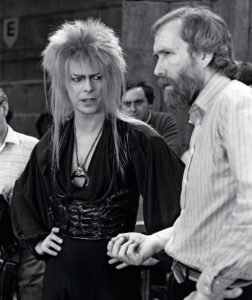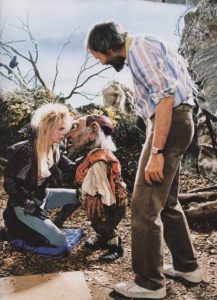
Jim Henson’s 1986 production Labyrinth holds a special place in the Henson canon (as well as in the hearts of many children of the 1980s). Its inception came after one of the first critical misfires of Henson’s film career, the ambitious The Dark Crystal (1982), which had sought to create a deeper and more sophisticated animated universe than anyone (the Henson company included) had ever attempted before. Though there is much to be said for The Dark Crystal, something about the principal characters, the Gelflings, did not coalesce, and the film achieves an earnestness which often seems to come at the expense of entertainment value.
With time, while ostensibly more crowd-pleasing, Labyrinth has revealed itself to be a film which explores issues just as deep as those of The Dark Crystal, but with a beguiling mix of Hensonisan and Pythonesque humour. One of the ways it achieves such a winning combination of light and dark, serious and absurd is with its mix of humans and puppets. Of course, previous Henson productions such as Sesame Street and The Muppet Show also ably mixed the two, creating animated universes where it did not seem so strange that on an otherwise normal New York street, some of the residents should reside in trash cans or giant nests, or that major celebrities of the day should wish to perform at a crumbling vaudeville theatre run by a chaotic cast of Muppets. But what Labyrinth added to the mix was a strangeness, an uncanny quality which mirrored the nightmarish quest of the protagonist, Sarah (Jennifer Connelly), to reclaim her baby brother from the goblin king Jareth (David Bowie) before 13 hours are up, and the baby is transformed into a goblin.

The ‘stunt’ casting of a pop star as the goblin king (at one time Michael Jackson was seriously considered for the role[1]) paid off, with Bowie’s edgy sexuality and indisputably alien quality fitting him perfectly for the role that is somewhere between love interest and tormentor: “Just fear me, love me, do as I say, and I will be your slave.” The most heartfelt theme of the film is what it is to be a girl on the cusp of adulthood – feeling betrayed and let down by her parents, still wanting to be looked after, yet also intrigued and frightened by adult responsibilities and adventures. The world of the Labyrinth, the Goblin City, and its king are both a ‘childish’ fantasy (puppets being a trope of childhood) and an intimation of the as yet unexplored world of romance and sex – here the puppets fulfill the Freudian role of the unheimlich, the uncanny, taking something known and making it strange.

The power of the figure of the puppet is at the heart of how Labyrinth achieves what it does. In a pivotal scene, Sarah encounters Jareth, who up to this point has seemed solely the antagonist, in a masked ball where humans wear goblin masks (essentially puppetized humans, perhaps followers of the Craigean notion of the ubermarionette). Under the influence of a mind-altering fruit, Sarah finally understands the sexual tension that has underscored all her encounters with Jareth, but realizes that she is not yet ready for this adult world. Seeming to break out of the bubble of her dream, she finds herself transported to her childhood bedroom. This too begins to feel uncomfortable and false, the heimlich rendered unheimlich, and her room turns out to be merely a simulacrum, which is torn down as the reality of it dawns on her.
Labyrinth takes everything Henson does best in his films and TV shows for children and reimagines it in a darker tone. It is a film for children, but also for adults who remember that childhood (and the transition to adulthood) is a frustrating, exhilarating, confusing experience. The cast of puppets and the animated universe they inhabit does not sugar-coat the strange or frightening things one may encounter. On the contrary, they also provide consolation, companionship, and humor. Labyrinth was very close to Jim Henson’s heart, and he took its initial failure at the box office hard, but thankfully he was aware of its growing cult status before his untimely death in 1990[2]. He left us with many animated universes, and that of Labyrinth should be considered one of the finest.
Tim Butler Garrett is an independent scholar, puppet maker, performer and director. He is a visiting lecturer at Wimbledon College of Art and editor of the British UNIMA journal Puppet Notebook.
References
Johnson, Kim ‘Howard’ (1993), Life Before and After Monty Python, New York: St Martin’s Press.
Jones, Brian Jay (2013) Jim Henson: The Biography, New York: Ballantine Books.
[1] Henson had considered Sting as well, but by the time of Terry Jones’ involvement, the choice seemed to be between Jackson or Bowie (see Jones, quoted in Johnson, 1993).
[2] Multiple Henson collaborators comment on how personally Jim took the fact that Labyrinth did not recoup its budget at the box office “I was stunned and dazed for several months trying to figure out what went wrong” (Jones, 2013:390). They also note that it later proved its popularity (and profitability) through video sales, T.V. broadcasts and merchandising.
